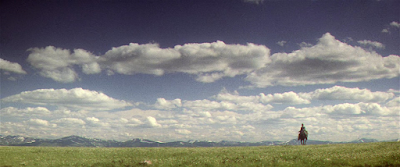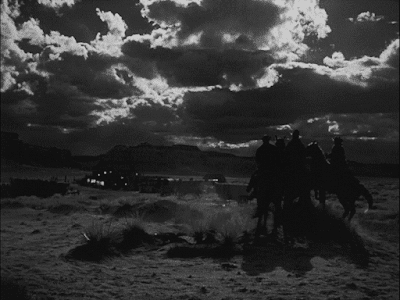The recent re-occurrence of the decennial Sight & Sound poll has inspired an outpouring of lists, thoughts about lists, complaints about lists, etc. My own opinion about it all is that—you know what, I’m actually going to refrain from voicing any opinions about it at all. But it makes one think about what one would put on one’s own list of the “ten greatest films of all time” and, well, here we are. I’ve always preferred lists that come with commentary so that the titles of the films don’t just stand there naked, somewhat impotent, easy for eyes to glaze over when reading. So I’ve made my own list with commentary on each entry. It’s presented in alphabetical order, and with the personal rule for the sake of variety to include only one film per director. Apologies to many films and directors for their stinging absence—most especially Chaplin, Bresson, Godard, Visconti, and Nick Ray—but here’s what I chose. (A more expansive and ranked list of my personal 100 favorite films can be found here.)
The 15:17 to Paris (Clint Eastwood, 2018)
Clint Eastwood was already a first ballot pantheon filmmaker before he ever entered his twilight years—which arguably began a quarter century ago already. Multiple late periods later (1997-2009, 2010-2019, 2021-??) he’s reached a sui generis place in the contemporary cinema landscape that one might turn to jokes to describe but is in fact too moving for me to truly articulate. At 87 years young he made this, an alien object that is perhaps more human than any other film released up to that point. Just normal people—so normal it is the actual people—thrust into a moment beyond time. The greatest film about divine providence. More experimental than most “experimental” films. Aggressively phenomenological and philosophical. I was caught off guard by how moved I was by it in my first encounter early in 2018, but revisiting it (and revisiting it and revisiting it and...) I literally cannot refrain from balling my eyes out during the climactic moments of this film. Words cannot suffice (even though I once tried); a movie where everything fades away and there’s just the people, their faces, and a prayer....
“I don’t know, man, d’you ever just feel like life is just catapulting you towards something, some greater purpose?”
The Godfather: Part III (Francis Ford Coppola, 1990)
The Godfather: Part III was a mercenary work. The Godfather: Part III was an
unnecessary work. The Godfather: Part III is also the highest Gesamtkunstwerk
in the history of American cinema. By film historical happenstance (& blindness)
it is little more than a footnote in the public consciousness to the first two Godfather
films Coppola made in the 1970s, but is in fact as great and greater than
those previous masterpieces. By being made 15 years after the fact, Coppola’s
career-long central theme of time is stamped on its very existence, on the
faces of Al Pacino, Diane Keaton, Talia Shire, and in the presence of 19-year-old
Sofia Coppola (after appearing as a newborn infant in the trilogy’s first film)
in what is one of the greatest performances (amateur or professional) in
the history of cinema. I’m getting stuck in superlatives: this film is a
magnificent opera, a two-and-a-half-hour novel, a series of religious
paintings, a ballet of bodies and words and whispers and glances. Michael’s
silent scream is the single most piercing moment in all of cinema, and a moment
I will never recover from.
The Green Ray (Éric Rohmer, 1986)
The greatest film about the philosophy of living. Rohmer flips through the summer calendar and gives us some shots and cuts, exceedingly normal and exceedingly beautiful. But we all know what we’re here for: the titular green ray, the appearance of which constitutes cinema’s greatest miracle. No other symbol of pure, unadulterated hope even comes close to the power of this little sliver of green squeezed between water and sky. And oh how earned it is—the little cuts and bruises of life, and also the big lonelinesses and longings of it, are so simply and realistically represented prior to this moment that the green ray feels like no less than God himself entering the movie to comfort me with a cosmic sign of infinite reach. Like Marie Rivière in the reverse shot, all one can do is laugh and cry at the absurd beauty of it all.
Heaven’s Gate (Michael Cimino, 1980)
The most titanic and monumental motion picture ever made. A near four-hour
post-Western slab of American melancholy that—thanks to Cimino’s stubborn commitment
to translating the impossibly grand artistic vision in his head into actual
reality and then onto actual film—you breathe in, wade through, and die along
with rather than just watch. This is the movie they should send to the aliens
in order to explain America. Visconti in the wild west. Its huge-ness is counterbalanced
by its infinite termiticism, every blade of grass and every cloud in the sky counting
for as much as its sweet romanticism and operatic tragedy. The coda with made-up-old
Kris Kristofferson on the verge of tears is the most succinct and moving
gesture ever recorded about America’s proclivity for snuffing out youthful idealism.
And American cinema’s snuffing out of Cimino for making this is almost too much
to bear.
A Hidden Life (Terrence Malick, 2019)
It’s hidden in the middle of this list of ten, but this is the greatest film of all time. There’s no recency bias here—I’m sorry that the greatest filmmaker of all time happens to still be alive and happens to make his best film every time he decides to make another one. But it almost feels wrong to have this film on this list in a way that it wouldn’t feel wrong to have any of his other 21st century pictures on it, because this film is post-cinema: yes, the shots and cuts are beautiful beyond words, and nobody can retain an emotional throughline within a fractured decoupage like Malick, but after an experimental modern-day trilogy our greatest film poet sat down and made a film about what really matters. This film is explicitly and specifically and quintessentially theological in the most profound way it is possible for a film to be, and which I dare say no other is. A hint at why: love, real love, real Christian love. This is all that matters. To quote the end of Song to Song: “This. Only This.”
I’d Climb the Highest Mountain (Henry King, 1951)
Humble Fox studio craftsman (read: artist) Henry King gave us this
humble masterpiece in a humble genre that he humbly excelled at: the pastoral. It’s
a somewhat rare genre that I’d suggest is made out of a combination of the
western and the melodrama—classic Hollywood’s two greatest staple genres. So to
say that I’d Climb the Highest Mountain is the best Hollywood pastoral
is to already say that it is one of the greatest films of all time. Only the essentials
here: love, family, religion, community, death, etc. Nothing about it on the
surface of things would alert you to the power it contains; its reputation (if
it even has one) as a more or less forgotten studio film is demonstrated by the
fact that no one has cared to restore it. But it is arguably the most utopian
film in the annals of Hollywood, and profoundly so because it doesn’t paper
over the sad realities of the world to be that. There’s nothing else like it.
My Darling Clementine (John Ford, 1946)
Two words: those clouds. The most elegant and beautiful and absolutely
head-to-toe perfect film classic Hollywood ever produced. John “I make westerns”
Ford was a poet and a genius and had more intuitive artistic sense for where to
place the camera and when to cut than 99% of the European arthouse masters, and
this film proves it. Every frame of My Darling Clementine is a sight to
behold, every movement of the camera is as natural as breathing, every actorly
gesture contains infinite unspoken meaning. All this for a simple little
western story that we’ve heard a dozen times before, of Wyatt Earp and Doc Holliday
and the shootout at the O.K. Corral, but this is a film seemingly touched by
God and therefore full of grace to the point of splendor. Ford made countless
other masterpieces but none were so casual in their pure brilliance as this;
none so beautiful in the fullest moral and aesthetic sense.
The Souvenir: Part II (Joanna Hogg, 2021)
Greatness is greatness is greatness is greatness, so to leave off a film just because it premiered last year is to lie to yourself and others. Like many of the greatest sequels this film sort of cheats by harnessing the power of not just one film but two: Joanna Hogg doubles down on the autobiographical drama of the first Souvenir film and then goes on to transcend it by the single most remarkable meta gesture in the history of cinema. Intellect and emotion, rigor and tenderness, Part II is intimate intimate intimate while also touching on the world-historical; it mines the auto-personal to reach a profundity that is vast—and impossibly moving. But all this happens on a small little level, the level of the cut, the level of the sound design, the level of a filmmaking intelligence tuned into every aspect small and large of what makes a movie a work of art. And of course this is all in service of something so simple yet so foundational: how to think, how to live....
Vertigo (Alfred Hitchcock, 1958)
I had planned to give this slot to Torn Curtain (1966), my
second favorite Hitchcock, to give that film a boost and to avoid giving a
space to a film that no longer really needs to be discovered—but then I
realized that this would be dishonest. There’s a reason Vertigo has been
a mainstay on such lists; there’s a reason it has a claim on being,
objectively, the greatest film of all time: because it’s the greatest film
about subjectivity. About subjective desires and the objective reality
preventing them. And it’s about this in a way that is both uncomfortable and
moving; the film latches on to the viewer’s heart like a leech, hypnotic,
un-look-away-able, sucking you in and indicting you—and it’s enjoyable, in
some twisted way. This is easily the darkest film on this list, a horror film
in the guise of a melodrama, a violent movie, an awful movie, a scarred and scarring
movie, and ground zero for what cinema is, ontologically, all about. This film
will be at the heart of cinema and cinephilia for as long as humans exist, and
this is both scary and beautiful.
The Yards (James Gray, 2000)
Bone-deep sadness and melancholia drip off this film like molasses. It
looks like a religious painting from the 17th century and moves like a turn of
the century Italian opera. It has the novelistic depth of a 19th century Russian
tome and the incisive social commentary of a 20th century French philosophical text. I’ve
already spent 12,000 words trying and failing to articulate the epochal
greatness of this film elsewhere,
but that’s apt: this is the art of the moving image we’re talking about here, which
at it’s most essential is inherently impossible to translate into words. So all
we have are emotions, feelings—and I don’t know how to share those with you
wordlessly. Perhaps by telling you (in words, alas) of how I encountered this
film at 18 and, for the very first time in my life, was moved to tears by a
movie—to ugly, torrential tears. This film will be with me forever.











.png)


No comments:
Post a Comment